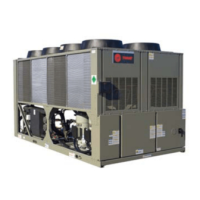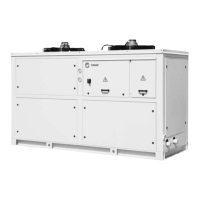CG-SVX17D-EN 155
Maintenance
Periodic Maintenance
General
Perform all maintenance procedures and inspection at the recommended intervals. This will
prolong the life of the chiller and minimize the possibility of malfunctions.
Use an “Operator’s Log” to record the unit’s operating history. The log serves as a valuable
diagnostic tool for service personnel. By observing trends in operating conditions, an operator can
anticipate and prevent problem situations before they occur.
If the unit is not operating properly during maintenance inspections, consult the “Diagnostic and
Troubleshooting” section of this manual.
Weekly Maintenance
Verify that compressor oil sump heaters are connected tightly around the compressor.
After the chiller has been operating for approximately 30 minutes and the system has stabilized,
check the operating pressures and temperatures and complete the following checks:
Check the evaporator and condenser refrigerant pressures in the Refrigerant Report menu of the
CH530 display. Pressures are referenced at sea level (14.6960 psia).
Check the electronic expansion valve sight glasses. (Note: The electronic expansion valve is
commanded closed at unit shutdown and if the unit is off, there will be no refrigerant flow through
the sight glasses. Only when a circuit is running will refrigerant flow be present.) The refrigerant
flow through the sight glasses should be clear. Bubbles in the refrigerant indicate either low
refrigerant charge or excessive pressure drop in the liquid line. A restriction in the line can
sometimes be identified by a noticeable temperature differential between the two sides of the
restriction. Frost may often form on the liquid line at this point. Correct refrigerant charges are
shown in the General Data Tables.
NOTICE:
A clear sight glass alone does not mean that the system is properly charged. Also check the
system superheat, subcooling and unit operating pressures.
NOTICE:
Use only manifold gauge sets designed for use with R-410A refrigerant. Use only recovery units
and cylinders designed for the higher pressure of R-410A refrigerant and POE oil.
NOTICE
Compressor Liquid Slugging!
Only add liquid in the suction line when the compressor is running. Use extreme caution to
meter liquid refrigerant into the suction line slowly. If liquid is added too rapidly, compressor oil
dilution and oil pumpout could occur. Failure to follow the above could result in compressor
failure or reduced compressor life.
Check the system superheat, subcooling, evaporator temperature drop (Delta-T), evaporator water
flow, evaporator approach temperature, compressor discharge superheat, condenser approach
and compressor RLA.
Normal operating conditions at AHRI Conditions (55-44°, 95° ambient, .0001ffe) are:
• Evaporator Pressure: 120 psig
• Evaporator Approach: 5-10°F
• Evaporator Superheat: 12°F
• Electronic Expansion Valve: 40-50 percent open

